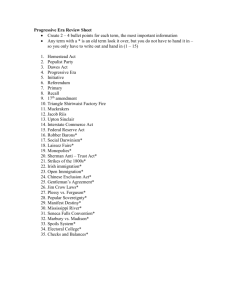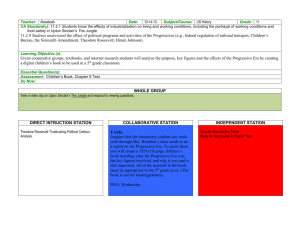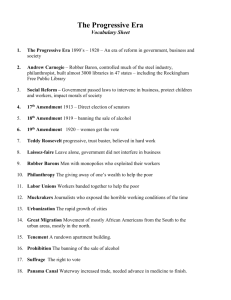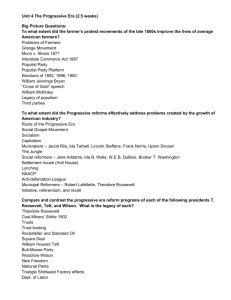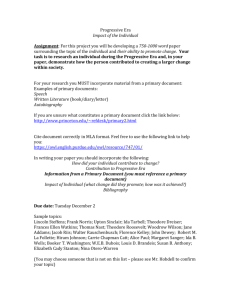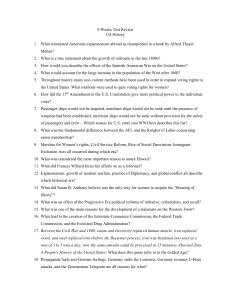The U.S. History Review
advertisement
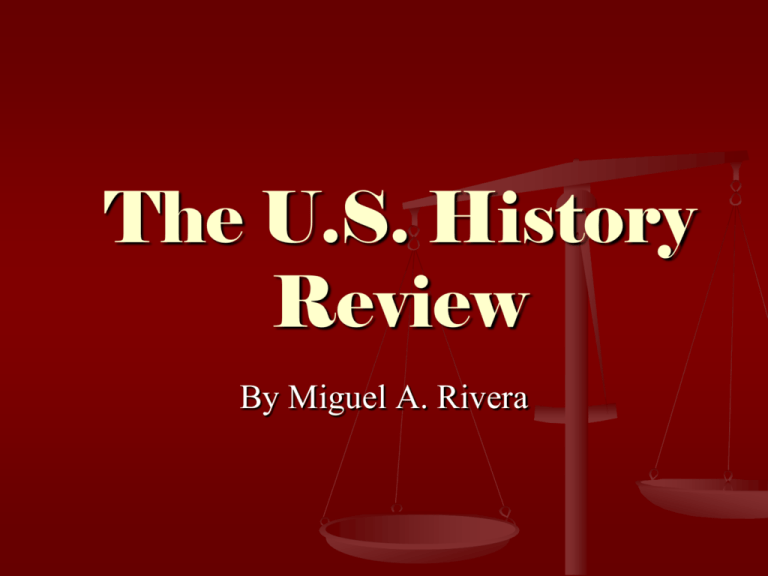
The U.S. History Review By Miguel A. Rivera Section 9 The Progressive Era What are some characteristics of the Progressive Era? Activity – Progressive Era Gather as much information as you possibly can about the Progressive Era in your group ½ picked to rotate will change seats every 2 ½ minutes, 2 minutes, and 1 ½ minutes after having brainstormed what you know We will come together as a class and figure out what you’ve put down. Progressive Era Time of Progressivism Collection of ideas, theories, and actions on how to fix America’s problems, particularly with rise of industrialization and urbanization in U.S. Time of Imperialism Taking over another country through economic and political (rather than military force) Some imperial countries took control over other territories, invested capital, and sold products. Progressive Era People are organizing in an effort to combat poor working conditions (unions) and writing about the bad things going on between business and government (muckrakers) People make changes to laws that allow them to: Vote for people based on initial campaigning (direct primary) Get behind a law they’ve written (initiative) Vote on issues rather than just people (referendum), and Take people out of office if not doing job (recall) Progressive Era 1898 Cuba starts a revolution against Spain, the U.S. gets involved and the Spanish American War begins and finishes Progressive Era 1903 The first automobile is sold by Henry Ford’s Ford Motor Company Progressive Era 1904 U.S. begins the development of the Panama Canal to increase trade between U.S., Europe and Asia Progressive Era 1914 Assembly line is fully developed by Henry Ford for his automobile company Panama Canal U.S. and Great Britain sign a treaty - U.S. exclusive rights to build and control any canal built through Panama. 1903 – Panama part of Colombia but declared independence in order to make their own deal with the U.S. U.S. backs up Panama in its short uprising against Colombia with ships, recognizes Panama’s independence and the U.S. and Panama sign a treaty to have the Panama Canal built 40-mile canal took 10 years (19041914) to build Shortens the distance from the Atlantic to the Pacific by 8,000 nautical miles Model T First car built by Henry Ford Manufactured in large numbers because of assembly line Isolationism Idea that the U.S. (or any country) should focus on solving domestic problems rather than international problems and separate itself from the rest of the world NAACP Political organization meant to improve equal rights for African Americans founded by W.E.B. Dubois and eventually led my Marcus Garvey U.S.S. Maine 1898 - U.S.S. Maine, anchored in Havana Cuba explodes and kills 266 American officers and sailors Although it is unknown why the ship exploded, Americans blamed Spain Rough Riders Volunteer cavalry regiments from the U.S. west including cowboys, miners and law officers with Theodore (Teddy) Roosevelt 2nd in command Helped win in San Juan Hill, Cuba. Open Door Policy All countries should be allowed to trade with one another Treaty of Paris of 1898 Cuba is an independent country U.S. acquires Puerto Rico and Guam U.S. pays Spain $20 million for Philippines. The Jungle 1906 – a book that describes Upton Sinclair’s observations in Chicago slaughterhouses (which is seen as horrific by many) Ultimately leads to the development of: The Meat Inspection Act Federal law that allows the Secretary of Agriculture to inspect all meat before it goes out to the public Can condemn meat if it is found to be inappropriate The Pure Food and Drug Act Federal law that also allowed the inspection of meat Forbade the manufacture, sale, or transport of pure food products and poisonous medicine Roosevelt Corollary 1904 – addition to the Monroe Doctrine U.S. will intervene in Latin American affairs when necessary Maintain economic and political stability in Western Hemisphere Progressive Era – Who’s this lady? Progressive Era – Who’s this lady? – Queen Liliuokalani Queen of Hawaii Disliked the influence of American settlers on Hawaii 1893 a group of planters supported by U.S. Marines forced the queen to give up her power after she tried to impose a new constitution that said how powerful she should be Planters and settlers set up a temporary govt. and eventually ask the U.S. to annex the islands Progressive Era – Who’s this guy? Progressive Era – Who’s this guy? – Jose Marti Exiled leader of Cuba who raised money in the U.S. after the first Cuban Revolution in 1868 failed. February 1895, Martí and his new followers began a new rebellion Seized control and set up an independent nation by September Progressive Era – Who’s this guy? Progressive Era – Who’s this guy? – Theodore (Teddy) Roosevelt Important president because he was a military leader, he was charismatic, tried different occupations Important environmentalist who develops the parks system Re-establishes presidency by taking on big business during Progressive Era Head is on Mt. Rushmore Progressive Era – Who’s this guy? Progressive Era – Who’s this guy? – Upton Sinclair Writer of The Jungle who was initially trying to write a book about his experience in the meat factories and eventually was considered a progressivist because people thought he had done it to expose the meat industry. Eventually saw himself as a leader for the cause Progressive Era – Who’s this lady? Progressive Era – Who’s this lady? – Susan B. Anthony Civil Rights leader who played an important role in getting women’s suffrage as a result of years of dedication End of the Progressive Era Now that you’ve completed this section, Make sure you’ve filled out all sections and definitions Complete the short answer questions that have been developed as a review for this section Prepare to move on to the next part of the presentation if you have time on World War I
